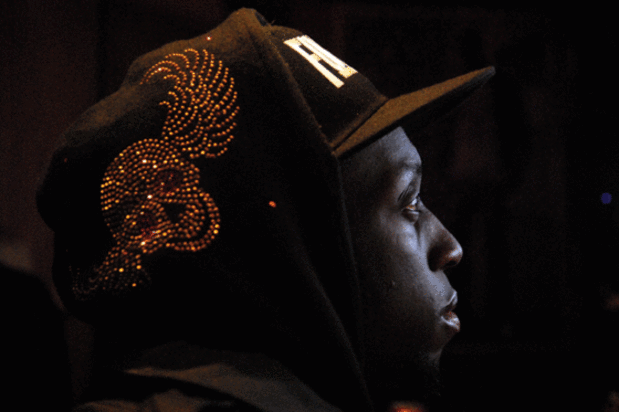Back in our April issue we jumped on the Ricky Blaze train early, documenting he and the Fire Unit's leading roll in the nascent Brooklyn underage dancehall scene, from pirate radio shows to hectic parties. Now, just in time for Ricky and company's summer takeover, you can get acquainted with our FADER 53 feature story after the jump.
Story Eddie "Stats" Houghton
Photography Peter van Agtmael
"No, man, it not gonna be like that this time, this is an older crowd, college kids. That other party you came to was a teenager thing, that’s why you see all that fighting an everything.” The speaker is Jr Vibes, a selector for the Brooklyn soundsystem called Fire Unit Squad, trying to convince someone, presumably a girl, that it’s safe to come out and see him perform with Ricky Blaze tonight. He is squeezed into the corner of a basement studio somewhere in Flatbush, the kind you enter through bomb-shelter doors that open onto the sidewalk of somebody else’s back yard. It’s about 1AM and along with Marky and Biggs—two other members of a loose-knit crew called the Rolling Stones—Jr is sitting around waiting for Blaze to burn off a CD of TV-track instrumentals so they can head to club De Jumbala, where Blaze is slated to perform for the birthday celebrations of Steely Bashment. Arguably Brooklyn’s biggest reggae DJ, Steely is also the proprietor of a pirate station called Waah Gwaan Radio, where Blaze and Jr broadcast a two-hour show every Wednesday night. Sitting at a ProTools console, Blaze, a slightly built and slightly horse-faced but nevertheless dapper Brooklyn youth of Jamaican descent, is the only one who doesn’t seem anxious to get underway. Over the last year he has become a ghetto celebrity of sorts with an uptempo reggae tune called “Cut Dem Off” and another—called “Love Dancing”—that he produced for the Jamaican group Merital. Without any kind of official release, both tracks—techno-fast and built out of icy synth and auto-croon hooks—have become runaway hits in a Brooklyn dancehall scene dominated by second-generation West Indian teens wilding out til all hours of the morning in spots like Jumbala, Elite Ark and Club Large. The buzz has even reached commercial outlets like Hot 97, where DJ Mr Cee has given “Cut Dem Off” a big run on his late night Friday slot. It’s not possible to judge exactly how popular the song is on YouTube because there’s no official video, just homemade joints by aspiring dance crews doing their own routines, but all of those seem to have hit counts well over a hundred thousand—a sign of the times in a season wherein Alicia Keys’ album hit #1 with only some 60,000 CD sales.

“Bare fuckery a gwan!” Now it’s Marky’s turn to let off. A half-hour later the crew has left the studio but they’re no closer to the stage. Instead they’re sitting in an SUV, parked at the BP gas station on Ralph Avenue where Marky has negotiated a five-dollar-per-car rate because even the hydrant spots are taken everywhere within a mile of the club. A mass of people several hundred strong is blocking the entrance and Blaze’s co-performers—Dingdong and a cat named Future—are apparently just getting dressed in a hotel in Queens. “No, nigga the club is ram. Ram ram ram ram!” Jr is on the phone again telling everyone he knows he can’t get them inside. Blaze is just sitting quiet in the passenger seat, pumping his own music and trying to keep the vibes. Sometime around 2AM, Dingdong and Future finally arrive, dipped in couture so outrageous it’s almost worth the agonizing wait. The party is billed as a “red and white affair,” and Dingdong is wearing what appear to be white Bally boots, white ice cream social slacks held up by white suspenders over a firetruck red dress shirt, topped off with a red-and-white checked PLO-solidarity keffiyeh around his neck and white plastic shades—the Kanye West kind that are slatted like venetian blinds.
Ding, as Blaze calls him, actually introduced him to the biz, using a beat from the then unknown 17-year-old on his hit 45 “Badman Forward, Badman Pull Up.” Reggae careers always start with the kid in the single digits,
but to make a long story short, as an ambitious teen, Ricardo Johnson parlayed a clerk job selling DVDs of Jamaica’s Passa Passa street dance at a Brooklyn record shop into an unofficial management gig for Ding, the scene’s premier dancer. Such a transformation is possible only because BK is by far the biggest market for Jamaican dance, and home to a thriving sister scene run mostly by Blaze’s underage constituency. “Dancing is so big in Brooklyn!” he told me the first time we met at his studio, a few days before the club show. “I want you to put this in big quotes, you know when y’all set out the big typeface: MTV SHOULD COME TO BROOKLYN. It’s like the South out here. It’s an epidemic.” That epidemic is now spreading, undoubtedly abetted by all the radio play of “Cut Dem Off.” Describing a recent performance for a mostly Trinidadian and Guyanese crowd in Queens, Ricky recalls in disbelief, “When I went there it was so major, it was like Kanye came to the club. I’m used to spots in Brooklyn where people don’t really bother me, only like teens. If I shook pass a high school, then I would have to worry about a hundred kids runnin up on me for autographs and pictures.”
It’s undoubtedly a certain soca-friendly tempo that’s allowed the tune to overcome the strict divisions that separate boroughs and immigrant groups, but when asked if he listens to soca or incorporates it in his DJ sets, Blaze replies, “Nah. Mostly techno. It has that soca vibe to it because of the uptempo-ness but my music is techno pop reggae. A lot of people confuse it with dancehall but it’s techno pop reggae…or I actually would say reggae techno pop.” He claims to pay no attention to producers, but off the top namechecks bassline heater “Heartbroken” by T2 and Jodie Ayesha as a current fav, an influence which sort of explains why a lot of his music sounds basically like trance with off-beat reggae drums. The strings, synth washes and vocoder create a palette of digital timbres that does to songs what a black light does to a club full of gyrating kids: gives everything a crystalline clarity, making it all brilliantly sharp-edged but far away in a manner that’s almost sad, like the sound of teenage desire and teenage alienation at once.

“What’s goin on in there? Everybody that come downstairs look mash up.” Now it’s Blaze’s manager Kim Lee who’s picked up the commentary. The VIP entrance is also the bumrush exit for patrons that have been cut off for being too drunk, belligerent or just passed out, like the inert dancer who’s being carried out past the barriers. (So much for the sophisticated older crowd.) Promoters pass by but in spite of armbands and passes, Blaze’s entourage can’t get a bligh with security. There are enough of them—burly ex-cops running the door in SWAT sweatshirts and real NYPD who have the avenue blocked off with a squad car and a ring of spitting flares—to make you wonder if the crime rate is spiking elsewhere in Brooklyn on this eerily warm night, a symptom of the winter storm that’s meant to be coming the next day. Every time another stumbling drunk or swirl of cat-fighting dancehall queens is ejected, a shoving match starts as the massive crowd parts to make room. Police grip their truncheons, bark into their walkie-talkies and rush around looking serious until about 3AM, when Blaze has had enough and suddenly decides that nobody’s birthday is worth standing out here waiting for a riot to happen in the pre-storm pressure drop.
On the way back to the car, we pass walls covered with slick, commercial-looking posters emblazoned with Blaze’s face and the words “RUMORS: album in stores soon.”
“That was the original plan, to put an album out independently,” he explains back at the studio. “But the buzz is getting so big now that record labels are callin, so we might accept one of those offers.” Running through the arsenal of tracks he’ll draw from, there is of course the expected “Cut Dem Off” remix with Ele and Matterhorn, but there’s also the BK rap of “For Life” and the lover’s rock of “Jolly My Baby,” which is creeping up in YouTube’s hit-rate with its block party video. The next track features a new jack swing violin pulse, with a hard 4/4 snare acting as metronome while Blaze alternates between crooning girl I need your attention in Akon mode and rapping in a Dr Evil cadence. Pretty soon he’s playing me straight pop songs with an ’80s Michael Jackson vibe, more Daft Punk than Dingdong. If there’s any quality that connects them all it’s a restless, almost compulsive musicality. In the 20 minutes between the time the tape stops rolling on our interview and when Marky arrives to swing us over to the pirate radio thing, Blaze taps out two or three complete tracks, including bridges variations and breakdowns. This offhand tour de force suggests the unsounded depths of Ricky Blaze: Pop Artist. But in the meantime, next weekend is Rolling Stones’ anniversary bashment at Albany Manor, followed by a slew of teen parties. And nestled in amongst all the bubblegum in ProTools is one more bat outta hell trancehall riddim, for the moment titled simply: “Another Fucking Dance Track.”


